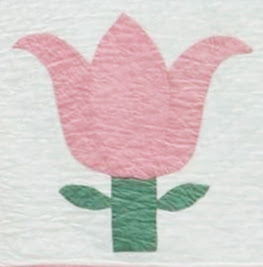In the late 1880s one could search Scammell's Universal Treasure House of Useful Knowledge and find patchwork designs in the T's for Textile Decoration. "The tulip block is to be pieced out of three different colors."
Scammell's may have influenced some quiltmakers to create that tulip block. Was the tulip pieced or appliqued?
Ladies Art Pattern #65 was even less graceful than Scammell's--- the stem
is a tree trunk.
Scammell's may have influenced Henry & Emma Brockstedt at the Ladies Art Company as they included a few Scammell designs in their Diagrams of Quilt Sofa & Pin Cushion Patterns, published several times after 1889. Scammell's also went through several editions from 1885-1889 so it is difficult to say which was first but I am betting on Scammell.
LAC pattern card
Awkward or not, the Ladies Art Company design was the basis for many quilts.
Although some redrew the pattern....
For better or worse
For some reason sometime I decided to redraw the pattern in EQ for a pieced and appliqued version similar to the Scammell/Ladies Art tulip. Here's a pattern at 8". Piece A B E & F. Applique C & D.
Or applique the whole thing! Piecing is crazy ambitious.
Even more influential was Ruby Short McKim who must have seen a Carolina tulip quilt and drawn a pattern about 1929 for the
Kansas City Star. It's in her book
101 Quilt Patterns.
Antique tulip of diamond leaves, lone block cut from a quilt
Her pattern is all appliqued and she tells you to make the tulip red--- red print in the small diamonds and she shows a red solid in the other tulip pieces. Like the Ladies' Art pattern the tulip is straight in the block, unlike most of the older Southern versions. She also changed the classic side shapes from green to a color to match the flower. McKim's smaller leaves with a point on the end are distinctive.
Quilts made from McKim's Tulip Applique are easy to spot.
From a Texas auction
Particularly if the tulip is all red.
From the Arizona project & the Quilt Index
Quilters often added outline embroidery in the fashion of
the 1930s like Georgie Culverhouse of Texas did.
Georgie's is modernism perfected.
New colors, old scale.
1930.
Someone enjoyed embroidery, dating this quilt 1930
soon after the pattern appeared. She also included other
embroidery designs by McKim.
Looks to be a sampler of Kansas City Star designs
Pennsylvania auction
Traditional color, McKim's design?
Spencer Museum of Art at the University of Kansas
Carrie Hall made a block for her book and called it Colonial Tulip.
Carolina Tulip may have been a better name.
I found many of these pictures on eBay. Tulips are still a popular image. Just search for tulip quilt and you can probably find some of these quilts still available.




























































